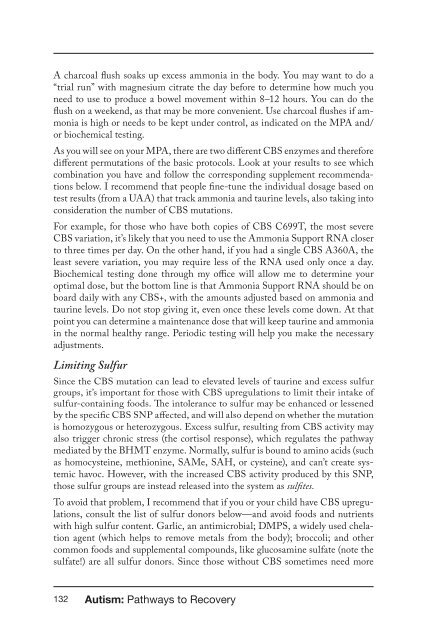3dT4E4Rnm
3dT4E4Rnm
3dT4E4Rnm
Create successful ePaper yourself
Turn your PDF publications into a flip-book with our unique Google optimized e-Paper software.
A charcoal flush soaks up excess ammonia in the body. You may want to do a<br />
“trial run” with magnesium citrate the day before to determine how much you<br />
need to use to produce a bowel movement within 8–12 hours. You can do the<br />
flush on a weekend, as that may be more convenient. Use charcoal flushes if ammonia<br />
is high or needs to be kept under control, as indicated on the MPA and/<br />
or biochemical testing.<br />
As you will see on your MPA, there are two different CBS enzymes and therefore<br />
different permutations of the basic protocols. Look at your results to see which<br />
combination you have and follow the corresponding supplement recommendations<br />
below. I recommend that people fine-tune the individual dosage based on<br />
test results (from a UAA) that track ammonia and taurine levels, also taking into<br />
consideration the number of CBS mutations.<br />
For example, for those who have both copies of CBS C699T, the most severe<br />
CBS variation, it’s likely that you need to use the Ammonia Support RNA closer<br />
to three times per day. On the other hand, if you had a single CBS A360A, the<br />
least severe variation, you may require less of the RNA used only once a day.<br />
Biochemical testing done through my office will allow me to determine your<br />
optimal dose, but the bottom line is that Ammonia Support RNA should be on<br />
board daily with any CBS+, with the amounts adjusted based on ammonia and<br />
taurine levels. Do not stop giving it, even once these levels come down. At that<br />
point you can determine a maintenance dose that will keep taurine and ammonia<br />
in the normal healthy range. Periodic testing will help you make the necessary<br />
adjustments.<br />
Limiting Sulfur<br />
Since the CBS mutation can lead to elevated levels of taurine and excess sulfur<br />
groups, it’s important for those with CBS upregulations to limit their intake of<br />
sulfur-containing foods. The intolerance to sulfur may be enhanced or lessened<br />
by the specific CBS SNP affected, and will also depend on whether the mutation<br />
is homozygous or heterozygous. Excess sulfur, resulting from CBS activity may<br />
also trigger chronic stress (the cortisol response), which regulates the pathway<br />
mediated by the BHMT enzyme. Normally, sulfur is bound to amino acids (such<br />
as homocysteine, methionine, SAMe, SAH, or cysteine), and can’t create systemic<br />
havoc. However, with the increased CBS activity produced by this SNP,<br />
those sulfur groups are instead released into the system as sulfites.<br />
To avoid that problem, I recommend that if you or your child have CBS upregulations,<br />
consult the list of sulfur donors below—and avoid foods and nutrients<br />
with high sulfur content. Garlic, an antimicrobial; DMPS, a widely used chelation<br />
agent (which helps to remove metals from the body); broccoli; and other<br />
common foods and supplemental compounds, like glucosamine sulfate (note the<br />
sulfate!) are all sulfur donors. Since those without CBS sometimes need more<br />
132 Autism: Pathways to Recovery


